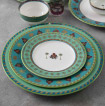| CERAMICS It is the 16th century and trade with European companies is gaining sway. Amongst other luxuries, the Portuguese bring in porcelain that is procured from the Chinese and sold in India, Persia and East Africa at four to ten times the original price. Exquisite and exotic, porcelain objects are reserved for the blue-blooded. China will dominate production of this family of ceramics, until a translucent variation of porcelain called English bone china is developed in 1797, England. It will soon become one of Britain’s most profitable trade items and the country will enjoy virtual monopoly over its production, right up to the late 20th century. Linked to royal extravagance and the British sahibs thus - in the Indian imagination - these materials will long linger as signifiers of high living. In 1955, Bengal Potteries Limited will become the first Indian company to manufacture bone china, followed by Hitkari Potteries some years after. But in the initial years, hotels - and not homes - will be their biggest clientele. Only a generation after Independence, once the middle class is less inhibited and more style conscious, will bone china reach domestic dinner tables. Floral dinner sets in particular, will be coveted as indexes of good taste and financial success. By the next century, plainer versions will be commonly used for routine meals; but decorative china will still be reserved for special occasions. Dinner Bowls Designer: Hitkari Potteries Year: c. 1960 Bowl with Floret Pattern Designer: Bengal Potteries Year: c. 1960 |
|||||
|
|||||


